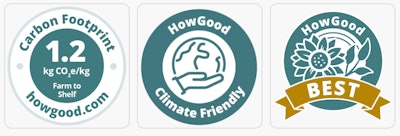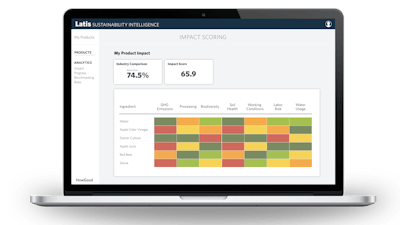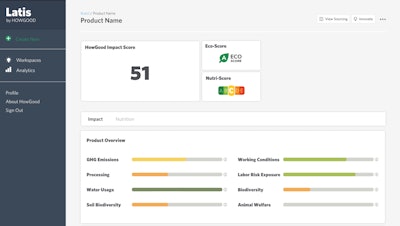Tuesday, June 18, 2024
"Carbon is the new calorie," declares
Lauren Porter, director of retail growth and innovation for
HowGood, an independent research company with the world’s largest database on food product sustainability. Porter dreams of a day when
every menu and food product will clearly outline the carbon impact of the item—and when consumers and event attendees will easily understand the context behind the numbers, just as they would reading the calorie count on a bag of chips.
Porter and the team at HowGood are working to make that dream a reality. "We have data analysis for more than 33,000 ingredients, food chemicals, and food materials," she explains, noting that her team regularly works with consumer goods brands, retailers, food service providers, and event organizers. "We provide in-depth, ingredient-level insights on factors ranging from greenhouse gas emissions to animal welfare and labor risk."
 HowGood places climate labels on packaging to let consumers know they're making an eco-friendly decision when buying food.Photo: Courtesy of HowGood
HowGood places climate labels on packaging to let consumers know they're making an eco-friendly decision when buying food.Photo: Courtesy of HowGoodThere seems to be growing interest in this type of carbon labeling. In fact, a
2022 study showed that consumers, regardless of location and type of event, will choose environmentally friendly food menu items if they understand their impact on the climate. Porter is encouraged to see more and more food service providers and event organizers wanting to implement carbon labeling on menus, noting that the team has worked on ingredient sourcing and climate labeling on menus at big events like COP28 and at venues like the Javits Center.
“Oftentimes, it’s because their demographic is demanding it," she points out. "From a
recent McKinsey study, we know that Gen Z and millennial consumers are the most interested in conscious-eating options—in fact, upward of 73% said they’re most concerned with the environmental impact of what they’re eating. This can really be a differentiator between one event provider and another."
 HowGood's platform, Latis, helps food retailers, brands, caterers, and event organizers source sustainable ingredients.Photo: Courtesy of HowGood
HowGood's platform, Latis, helps food retailers, brands, caterers, and event organizers source sustainable ingredients.Photo: Courtesy of HowGood By analyzing greenhouse gas (GHG) emissions, water usage, working conditions, and more, Latis calculates an overall HowGood Impact Score for each food product.Photo: Courtesy of HowGood
By analyzing greenhouse gas (GHG) emissions, water usage, working conditions, and more, Latis calculates an overall HowGood Impact Score for each food product.Photo: Courtesy of HowGoodFor event organizers who want to start considering climate labeling, Porter offers some ideas of where to start.
1. Choose a partner wisely.
Whether partnering with HowGood or another organization, she stresses the importance of finding an experienced partner in this process. “Events evolve quickly, and menus can change quickly based on sourcing needs," she notes. "You need a partner that can be really reactive and agile with you."
Another important consideration? Find a partner that has third-party assurance. “What a partner brings to the table should be mitigation of risk, whether that be reputation risk—like accusations of 'greenwashing'—or regulatory risk," she explains. "HowGood has third-party assurance from the Carbon Trust, for example, and it shows that industry experts have analyzed our methodology.”
2. Be prepared for “truth-disrupting moments.”
Porter encourages event organizers to "be bold and be a leader" in this space—and to prepare themselves for potentially difficult or surprising conversations with their culinary teams or event venues," she says. “We have what we call ‘truth-disrupting moments’ with our clients all the time. Oftentimes, people specifically focus their sustainability efforts on recycling and packaging, but, ultimately, that’s typically only 5% to 7% of the total carbon impact of the food being provided. The bulk of the impact is coming from the actual ingredient choices that are made.”
3. Provide context for your attendees.
Before food products and restaurants started offering in-depth nutritional information, consumers didn't have a lot of context for what a calorie or a carbohydrate was in relation to their daily lives, Porter points out. "But today, I can pick up a soda or a bag of chips and tell you, without looking at the label, pretty close to how many calories are in it," she says. "That’s where we’re headed with carbon—but consumers need the context and guidance."
While it may not be an option to print extensive educational materials directly on menus, Porter suggests doing it via backlinks or QR codes, or even through signage on site. She also advises incorporating messaging before and after the event—which can only help your marketing efforts. "Prepare attendees with communication on this initiative, and follow up afterward with a survey or a receipt that shows the impact of their choices. It’s really about getting the most ROI out of this investment as you can.”